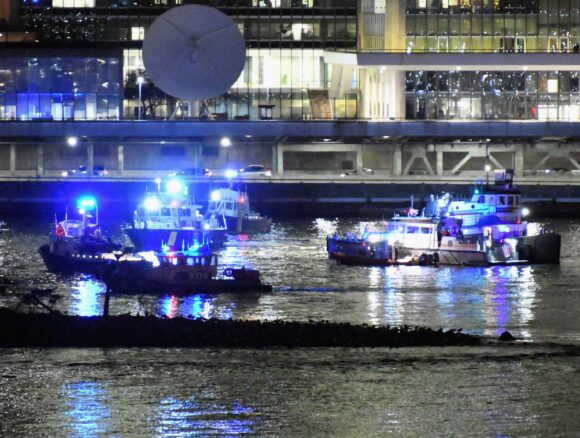The five people who signed up for a helicopter sightseeing flight above New York City three years ago might have expected that aviation regulators were looking after their safety.
But the reality of that fatal flight on March 11, 2018, was very different. The operator had declared that it was an “aerial photography” flight that made it exempt from stricter commercial rules.
After the aircraft lost power and splashed down in the East River, all five drowned because they were tethered into the seats with restraints that hadn’t been approved for safety, investigators concluded.
They were among more than 40 people killed since 2016 in air tours and other flights-for-hire that are exempt from commercial aviation safety rules, the U.S. National Transportation Safety Board said at a meeting Tuesday. The NTSB issued six recommendations for tighter rules over such flights that operate commercially and reiterated three earlier recommendations.
Typically, carrying passengers for hire triggers more government oversight, said NTSB Chairman Robert Sumwalt, “that is, unless you get an exception, an exemption, an omission or an exploitation of a loophole in the regulations.”
The flights include World War II aircraft, hot-air balloons, planes carrying parachutists and some air tours, according to the NTSB.
“I think the public in general would be really surprised by what is required of these operations and not required,” NTSB board member Jennifer Homendy said.
Unlike typical commercial operations, these flights that fall through the regulatory cracks don’t have to have approved maintenance or pilot training programs. There also aren’t rules for drug and alcohol testing or limits on how long a pilot can work each day.
Paid sightseeing trips aboard gliders are treated as if they are lightly regulated private flights because there are no federal regulations governing them, the NTSB said.
In addition to the 2018 helicopter crash, multiple cases illustrate the loopholes, according to NTSB records:
- On Oct. 2, 2019, a 75-year-old B-17 bomber crashed in Windsor Locks, Connecticut, killing seven people. Because it was a historic aircraft, the operator had an exemption from the normal Federal Aviation Administration commercial rules and had had little or no contact with agency inspectors in the two years before the crash.
- A hot-air balloon crashed near Lockhart, Texas, on July 30, 2016, killing all 16 people aboard in the deadliest U.S. aviation accident since 2009. The pilot had multiple health problems that should have prevented him from flying and had taken prohibited drugs, but balloon pilots are exempt from receiving medical checks most others must get.
- A turboprop carrying parachute jumpers slammed into the ground shortly after takeoff from an airport in Mokuleia, Hawaii, on June 21, 2019, killing all 11 people aboard. Even though the parachutists had paid for the flight, it was regulated as if it were being operated by a private pilot.
- A pilot and his passenger died on Oct. 21, 2017, in Four Corners, California, after losing control during a “Top Gun” acrobatic demonstration. Normally, such flights would be considered commercial and subject to higher FAA scrutiny, but this one was being operated under an exception for “flight training.”
The FAA, which is charged with regulating the aviation industry and ensuring safety, is crafting new regulations to tighten oversight of balloon pilots and to require more rigorous internal safety organizations for all operators carrying passengers for hire, it said in an emailed statement. After the New York helicopter accident, it also imposed new restrictions on photography flights.
“The FAA has a number of initiatives under way to improve safety” and has worked closely with NTSB on the issue, it said.
The agency has at times faced challenges. A 2018 law setting policy for the FAA required the agency to “streamline” how it approves flights operated by private owners, which includes many of the cases being reviewed by NTSB.
The NTSB is calling on the FAA to take multiple steps to tighten its oversight of companies operating in the less regulated sphere while carrying passengers for hire.
The recommendations call on FAA to identify and close loopholes, develop standards for all operators carrying passengers for hire, give more training and guidance to its safety inspectors and create a database tracking such operations.
Investigators said they don’t want to force small tour operators to shut down or to become regulated as if they were a large commercial airline or charter group. Instead, the FAA should consider creating a new level of regulation appropriate for operations that currently fall through the cracks, said Elliott Simpson, an investigator who led the NTSB review.
The safety board also doesn’t want to add new oversight to flight schools or the thousands of private pilots, Simpson said.
The FAA and other entities receiving recommendations have no legal obligation to follow them, but they must respond and the suggestions often lead to changes.
About the changes: At least 2 dead as helicopter crashes into New York City’s East River on March 11, 2018 in New York City. (Photo by Dimitrios Kambouris/Getty Images)
Was this article valuable?
Here are more articles you may enjoy.


 Supreme Court Allows More Transport Workers to Bypass Arbitration and Sue Employers
Supreme Court Allows More Transport Workers to Bypass Arbitration and Sue Employers  US Eyeing Ship’s Electrical System After Baltimore Bridge Crash
US Eyeing Ship’s Electrical System After Baltimore Bridge Crash  Travelers Survey: Distracted Drivers Making US Roads More Dangerous
Travelers Survey: Distracted Drivers Making US Roads More Dangerous  CoreLogic Report Probes Evolving Severe Convective Storm Risk Landscape
CoreLogic Report Probes Evolving Severe Convective Storm Risk Landscape 